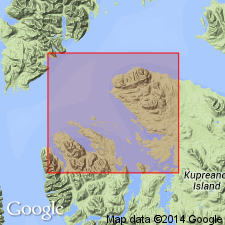
- Usage in publication:
-
- Halleck Formation*
- Modifications:
-
- Named
- Dominant lithology:
-
- Siltstone
- Sandstone
- Limestone
- Conglomerate
- Basalt
- AAPG geologic province:
-
- Alaska Southeastern region
Summary:
Type locality designated as tidal flats of Halleck Harbor, northeast shore, Saginaw Bay, northern Kuiu Island, southeastern AK. Reference section designated as exposures on tidal flats on east side of Saginaw Bay south of abandoned cannery. Crops out also on several Keku Islets. Is heterogeneous sequence of siltstone, sandstone, limestone, conglomerate, and basaltic rock. Dominant rock type in Saginaw Bay is dark-gray very calcareous siltstone that grades into silty limestone. Pillow lavas, pillow breccias and epiclastic volcanic breccias of olivine-rich basalt occur near middle of unit southeast of Halleck Harbor. Is approximately 700 ft thick on northeast shore of Saginaw Bay. In Saginaw Bay conformably overlies Saginaw Bay Formation (new); conformably underlies Pybus Formation. Is probably lateral equivalent of Cannery Formation. Shown on geologic map of Keku Islets and neighboring parts of Kuiu and Kupreanof Islands. Is Early Permian age (probably Leonard, J.T. Dutro, Jr., oral commun., 1963) based on fossils.
Source: GNU records (USGS DDS-6; Menlo GNULEX).
For more information, please contact Nancy Stamm, Geologic Names Committee Secretary.
Asterisk (*) indicates published by U.S. Geological Survey authors.
"No current usage" (†) implies that a name has been abandoned or has fallen into disuse. Former usage and, if known, replacement name given in parentheses ( ).
Slash (/) indicates name conflicts with nomenclatural guidelines (CSN, 1933; ACSN, 1961, 1970; NACSN, 1983, 2005, 2021). May be explained within brackets ([ ]).

